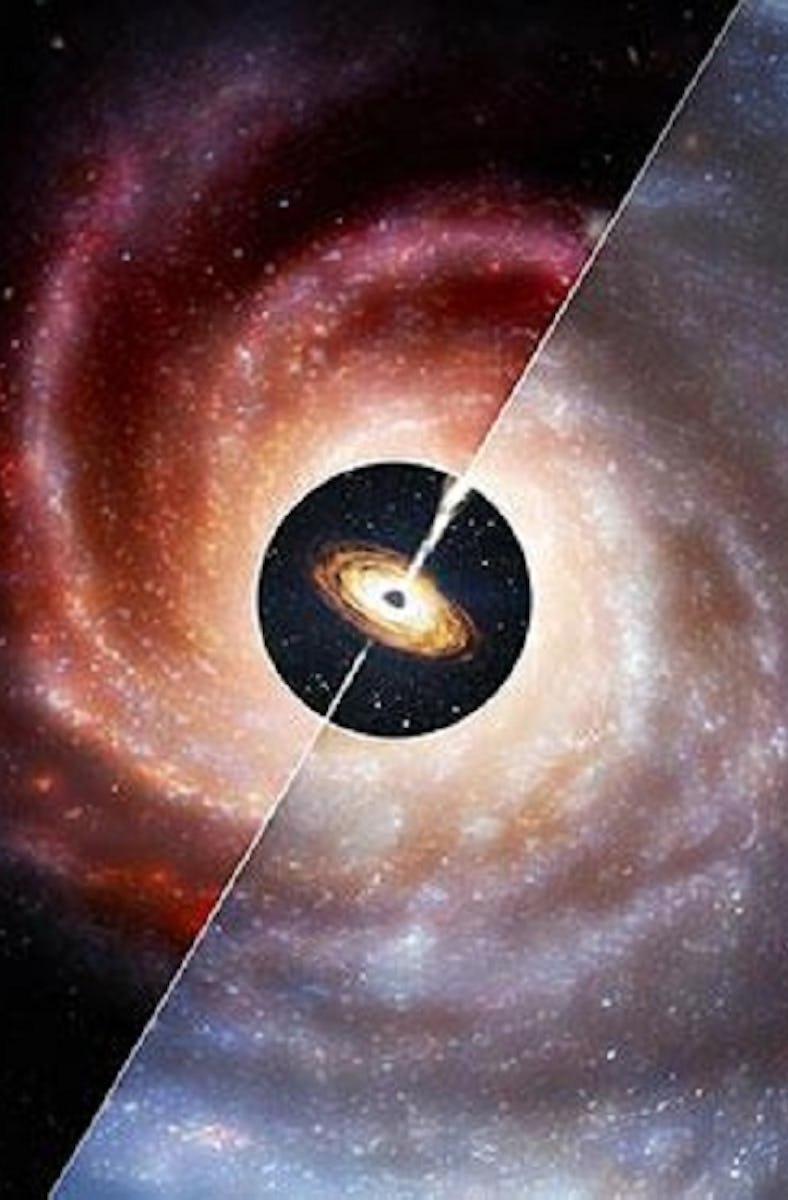‘Overmassive’ Black Holes Dominated Early Galaxies, Study Finds
And you thought Sagittarius A* was big.

Peering back into the early universe with NASA’s James Webb Space Telescope (JWST) over the past few months, astronomers have noticed something odd. The supermassive black holes lurking at the heart of ancient galaxies are smaller than the ones in our nearby, modern slice of the universe. However, compared to the mass of stars in their host galaxies, these black holes almost seem too big.
In a new paper, Harvard University astrophysicist Fabio Pacucci and his colleagues suggest that these early black holes were thousands of times our Sun’s mass, likely spawned by enormous clouds of gas collapsing under their own gravity. These early black holes were also relatively more massive than their galaxies, but these galaxies gained stellar mass over time. The scientists published their work in The Astrophysical Journal Letters in October, and Pacucci presented the study at the 243rd meeting of the American Astronomical Society (AAS) this week.
This image illustrates how the ratio of black hole mass to stellar mass differs between nearby (recent) and distant (ancient) galaxies.
“Overmassive” Black Holes
We think of supermassive black holes as immense, star-swallowing leviathans lurking at the center of galaxies, but the stars in any given galaxy actually outweigh the supermassive black hole at the center by a factor of 1,000 to 1. That’s the case in our Milky Way Galaxy, and in most of the other galaxies we see in the nearby universe, but these galaxies have had billions of years to grow and evolve since the beginning of the universe.
Over the last few months, astronomers have published what Pacucci describes as “an explosion of studies” reporting ancient, distant galaxies with supermassive black holes that seem too massive – or “overmassive,” as Pacucci puts it to the AAS crowd.
Because JWST lets astronomers look farther back in the universe to see smaller, more distant objects, this has shed more light on how galaxies — and the supermassive black holes at their hearts — evolved. And it turns out that between 12 and 13 billion years ago, some galaxies’ stars accounted for only ten times as much mass as their supermassive black holes, meaning early galaxies sort of grew into the larger supermassive black holes at their centers as billions of years passed.
A Black Hole Origin Story
While these “overmassive” black holes indicate how galaxies evolved and grew, they could also resolve a debate about what the “seeds” of modern supermassive black holes were like. The first black holes formed a few hundred thousand years after the Big Bang, and eventually, they evolved into supermassive black holes like the one at the heart of our own galaxy. But astronomers still don’t agree on how large a “seed” our friendly neighborhood supermassive black hole, Sagittarius A*, started out as — or exactly how it formed.
One option is that the first black holes formed when the first generation of massive stars burned out their fuel and collapsed, leaving behind black holes of just a few hundred times the mass of our Sun.
The other possibility is that the seeds of supermassive black holes formed even earlier in time when giant clouds of very dense gas collapsed under their own gravity. These clouds, according to the theory, would have been too enormous and too dense to form a mere star, and instead, they collapsed into black holes between 10,000 and 100,000 times more massive than our Sun. These heavy black hole seeds would have contained about as much mass as all the stars in their host galaxies.
According to Pacucci and his colleagues’ models, smaller black hole seeds couldn’t have grown quickly enough to become the “overmassive” black holes like the ones JWST sees in galaxies dating back to 12 billion years ago.
“Many studies suggest that if seeds formed heavy, then in the distant universe, the ratio between stellar mass and black hole mass should be [smaller],” says Pacucci. “This discovery suggests that black hole seeds may have formed heavy.”
An Oversized Mystery
So why did early galaxies’ supermassive black holes weigh so much in comparison to all the stars in the galaxy? One possibility, suggests Pacucci, is that those newborn black holes were active and voracious, and because black holes are messy eaters, that meant the young black holes were flinging radiation and electrically charged gas all over the place.
That turbulence and radiation would have made it difficult for clouds of gas to settle down in and form stars.
Eventually, as the black holes calmed down and spent less time feeding, they allowed more stars to form in the galaxy, tilting the balance more in the stars’ favor. Over time, smaller galaxies merged to form larger ones (a process that’s still happening today). Although those mergers would have led to larger supermassive black holes, they also would have triggered new waves of star formation, further boosting the galactic ratio we see today.
“Over cosmic time, we know that the ratio of stellar to black hole mass progressively catches up with the local 1000 to 1 ratio of the modern universe. This happens as the black hole and its host galactic system evolve together, merging with other galaxies and forming legions of stars,” says Pacucci. “What we're still working on is seeing deeply enough into the universe to piece together how this all got started.”